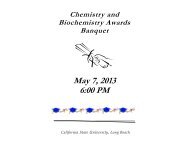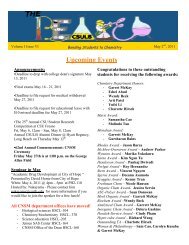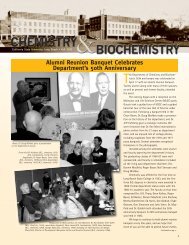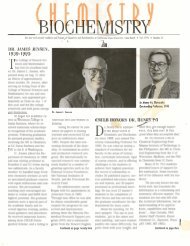2011 - California State University, Long Beach Department of ...
2011 - California State University, Long Beach Department of ...
2011 - California State University, Long Beach Department of ...
Create successful ePaper yourself
Turn your PDF publications into a flip-book with our unique Google optimized e-Paper software.
Reports from Faculty<br />
12<br />
Continued from pg. 11<br />
Gomez and Kelvin Oh. Graduate student Astor<br />
Suriano will be finishing up during summer<br />
<strong>2011</strong>. Kim Tu, who completed her first year <strong>of</strong><br />
our chemistry M.S. program, maintained a 4.0<br />
in her course work and will be working on the<br />
chiral synthesis <strong>of</strong> organophosphorus<br />
compounds.<br />
I have been involved in teaching the<br />
advanced organic laboratory course (CHEM<br />
420) since fall 2007. While the course coordination<br />
has been passed along to Dr. Young<br />
Shon this past spring, I will continue to teach<br />
a lab section. I've also started teaching the<br />
CHEM 322 series, the organic chemistry lecture<br />
for biosciences majors. The course has its<br />
own challenges, but I enjoyed applying Cal<br />
<strong>State</strong> L.A. emeritus pr<strong>of</strong>essor Don Paulson's<br />
active learning strategy in its instruction. During<br />
most <strong>of</strong> June <strong>2011</strong>, our group was busy<br />
moving into the new Hall <strong>of</strong> Science laboratory.<br />
Everyone is excited about the brand new<br />
laboratory environment.<br />
Photo by Victoria Sanchez<br />
Darin Khumsupan, left, and Roy Hernandez try to figure out<br />
why their experiment did not work… maybe someone out<br />
there will have an answer.<br />
Dr. Vas Narayanaswami<br />
It feels like a long time ago in a galaxy<br />
far, far away, but it’s only been a year…. boy, it<br />
went with the speed <strong>of</strong> light.<br />
I had a fantastic trip to Singapore to give<br />
a talk about the use <strong>of</strong> apoE-containing<br />
reconstituted HDL as drug delivery nanovehicles<br />
at NeuroTalk 2010, First Annual World<br />
Congress: From Nervous Functions to Treatment.<br />
I presented work initiated by Panupon<br />
Khumsupan, which was later continued by<br />
undergraduate students Ricardo Ramirez and<br />
Darin Khumsupan, who were funded by an<br />
NIH summer stipend and NHK Laboratories,<br />
Inc, respectively, in summer 2010. The work<br />
was subsequently published in Biochim Biophys<br />
Acta in early <strong>2011</strong>.<br />
During the fall semester, three new bio-<br />
chemistry graduate students joined my lab: Roy<br />
Hernandez, Ken Irvine and Sea Kim. Gursharan<br />
Bains, a biochemistry degree graduate student,<br />
and I went to San Diego, Calif., for the Society<br />
for Neuroscience’s 40th annual meeting. The fall<br />
semester ended on that fateful day in mid-<br />
November, which in retrospect seems like a<br />
bizarre and surreal dream, when I gave the Fellows<br />
Colloquium talk, fancifully titled “Could<br />
This ‘Trojan Horse’ Help End the War on<br />
Alzheimer’s?”. At exactly the time I was extolling<br />
the advantages <strong>of</strong> transporting bi<strong>of</strong>lavonoids in<br />
HDL to potentially treat Alzheimer’s disease, my<br />
family was performing the final rites for my<br />
mother halfway across the earth; she succumbed<br />
to an Alzheimer’s like disease. The timing was<br />
uncanny! This is a tough one to come to terms<br />
with…time will surely help.<br />
Our group stayed under the radar during<br />
the winter break. Several undergraduate students,<br />
Tuyen Tran, Tien Vu, Darin Khumsupan,<br />
Muhammad Rafay and Raul Vera; Gursharan<br />
and I presented our work at the January <strong>2011</strong><br />
Annual CSU Biotechnology Symposium, which<br />
was held in Orange County. Gursharan was one<br />
<strong>of</strong> the finalists for the Don Eden Graduate Student<br />
Award competition at this meeting.<br />
Spring semester rolled in, and with it, the<br />
deadlines for grants, awards, fellowships and<br />
conference visits. Tuyen Tran and Darin Khumsupan<br />
presented their work in oral presentations<br />
at the <strong>2011</strong> Southern <strong>California</strong><br />
Undergraduate Research Conference in Santa<br />
Barbara, Calif. Gursharan and I attended the<br />
<strong>2011</strong> Arteriosclerosis, Thrombosis and Vascular<br />
Biology Council Meeting <strong>of</strong> the American Heart<br />
Association (AHA) in Chicago, Ill., where we<br />
had a poster presentation. She was also one <strong>of</strong><br />
two students selected to represent CSULB at<br />
the 25th annual CSU Student Research Competition<br />
in Fresno, Calif., in May <strong>2011</strong>. Tuyen<br />
Tran and Aishwarya Venkataraman, a Stanford<br />
<strong>University</strong> undergraduate student, applied for<br />
the <strong>2011</strong> AHA undergraduate summer fellowship<br />
to carry out research in my lab. Both won<br />
this prestigious and highly competitive award.<br />
Also, Tuyen Tran and biochemistry graduate<br />
student Roy Hernandez won the NIH-sponsored<br />
Children’s Hospital Oakland Research<br />
Institute summer research fellowship. Roy<br />
plans to spend time this summer in our collaborator’s<br />
lab, Oregon <strong>State</strong> <strong>University</strong> at Corvallis,<br />
performing mass spectral analysis <strong>of</strong> apoE.<br />
Lastly, the news <strong>of</strong> a successful <strong>2011</strong> CSUPERB<br />
Faculty Development Grant for the potential<br />
use <strong>of</strong> apoE containing HDL as a nanovehicle<br />
to transport bi<strong>of</strong>lavonoids signals the beginning<br />
<strong>of</strong> a busy summer ahead for us.<br />
It is with a heavy heart that I am bracing<br />
myself to bid farewell to biochemistry<br />
graduate student Arti Patel, who will be<br />
defending her thesis at the end <strong>of</strong> the spring<br />
semester. I thank her for shouldering the bulk<br />
<strong>of</strong> the biophysical experimental work on HDL<br />
mimetic peptides in our collaboration with<br />
Dr. John Bielicki at the Lawrence Berkeley<br />
National Laboratory. It earned her a first coauthorship<br />
in Biochemistry in April <strong>2011</strong>. She<br />
will be headed to Boston, Mass., to start her<br />
Ph.D. program at Tufts <strong>University</strong> this fall.<br />
Farewell, R2D2, may the force be with you!<br />
Dr. Michael Schramm<br />
"A guest has not to thank the host, but<br />
the host the guest" –Russian Proverb<br />
Molecular recognition is the study <strong>of</strong><br />
how and why molecules interact. At its<br />
essence lies the attraction <strong>of</strong> molecules at<br />
energy levels “weaker than covalent.” Hydrogen<br />
bonding, metal coordination and the<br />
hydrophobic effect cover some <strong>of</strong> these possible<br />
forces. In nature, we find countless, crucial<br />
interactions predicated on noncovalent<br />
interactions such as enzyme-substrate recognition,<br />
DNA-protein binding and ion-receptor<br />
transport. From a synthetic point <strong>of</strong> view,<br />
these principles have strongly influenced<br />
areas <strong>of</strong> research from drug design to materials<br />
science to molecular self-assembly. Our<br />
research uses molecular recognition as a<br />
design principle to develop new synthetic<br />
molecules that are compatible with, and<br />
capable <strong>of</strong>, regulating biological function.<br />
Current efforts in the Schramm research<br />
group utilize the principles <strong>of</strong> molecular<br />
recognition to solve chemical problems. We<br />
are actively preparing and now screening a<br />
1,000-member small-molecule library <strong>of</strong><br />
alpha-helical peptidomimetics. This collection<br />
<strong>of</strong> compounds is designed to target a spectrum<br />
<strong>of</strong> protein-protein interactions based on<br />
the alpha-helix. In generating these molecules,<br />
we hope to have a collection <strong>of</strong> compounds<br />
suitable for modulating several<br />
biological pathways. Our first screens will<br />
target the p53-HDM2 and BAX-Bcl proteinprotein<br />
recognition events, which are a cornerstone<br />
<strong>of</strong> study for the development <strong>of</strong><br />
new chemotherapeutics. This year, Cindy<br />
Pham contributed significantly to this project.<br />
I presented this work at Pacifichem 2010<br />
in Honolulu, Hawaii. While there, I had time


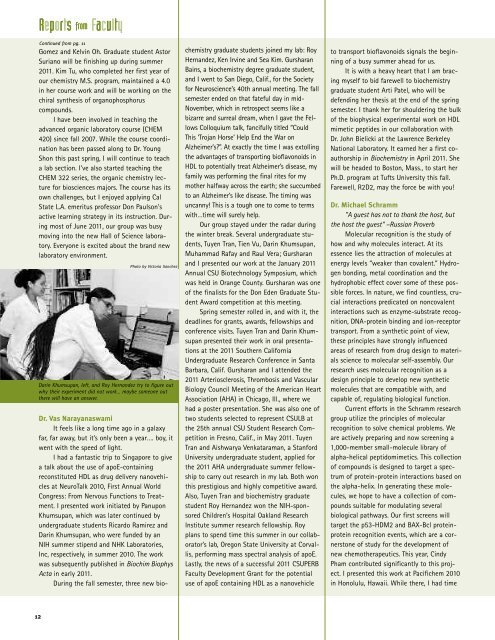
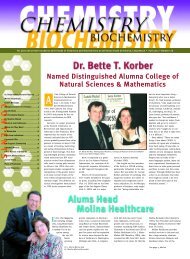
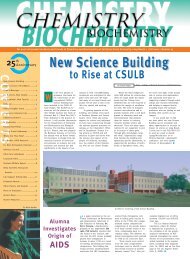
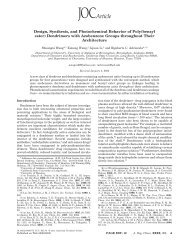
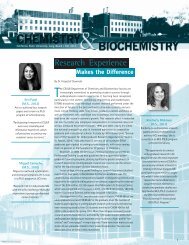
![Volume 4, Issue 3 [November 2012 pdf] - California State University ...](https://img.yumpu.com/34605825/1/190x245/volume-4-issue-3-november-2012-pdf-california-state-university-.jpg?quality=85)
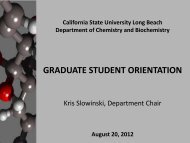
![Volume 5, Issue 2 [April 2013 pdf] - California State University, Long ...](https://img.yumpu.com/33273195/1/190x245/volume-5-issue-2-april-2013-pdf-california-state-university-long-.jpg?quality=85)
